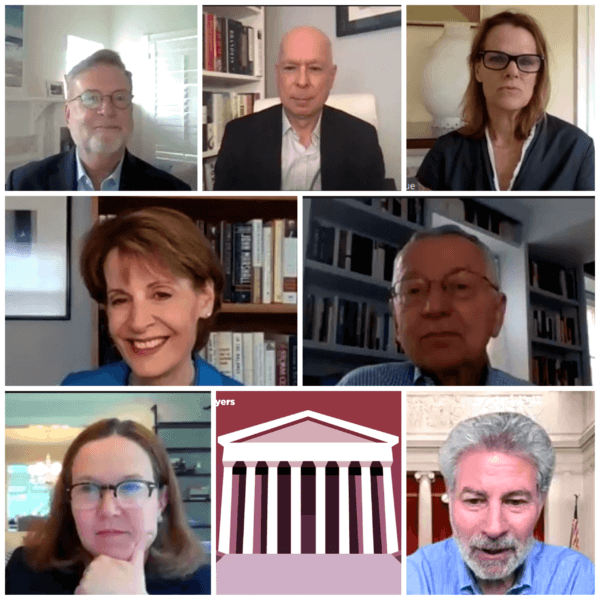
Supreme Court: View from the Press Gallery 2021 Recap
By Amelia Patrick
On Wednesday, July 7, 2021, over 225 law students, lawyers, and legal aficionados attended Supreme Court: View from the Press Gallery, our annual panel of journalists who dish and discuss the inside scoop on SCOTUS, and the Justices. Art Spitzer, Senior Counsel of ACLU-DC, moderated the panel with these distinguished Supreme Court journalists:
- Robert Barnes, Washington Post Supreme Court Reporter
- Joan Biskupic, CNN Legal Analyst and Author
- Ariane de Vogue, Reporter and Producer for CNN Politics Covering Legal Issues and the Supreme Court
- Amy Howe, Author of the Blog “Howe on the Court” and Independent Contractor and Reporter for SCOTUSBlog
- Adam Liptak, New York Times Supreme Court Reporter and Writer of the Legal Developments Column “Sidebar”
- David Savage, Los Angeles Times Legal Issues and Supreme Court Reporter
The first topic that the panelists discussed was the 82-year-old Justice Breyer. Some are wondering whether Judge Breyer will retire soon. His retirement would allow President Biden to nominate a left-leaning Justice for the Democrats in the Senate to confirm. However, indications are that Justice Breyer does not want to leave the bench. The journalists weighed in on why this may be the case. Joan speculated that some of Justice Breyer’s hesitation to leave the Court may be due to his experience as a law clerk for Supreme Court Justice Arthur Goldberg. Justice Goldberg was strong-armed by President Lyndon B. Johnson to leave his position and ultimately regretted this decision to retire. Joan mentioned that this could have made a lasting impact on Justice Breyer, teaching him that Justices should retire on their own terms.
Whatever the reasons, it seems that Justice Breyer is not ready to retire yet. He is embracing his move into the position of senior liberal justice on the left, and authored several big decisions during this past term. It may be that he wants to experience that power for a bit longer. Or, it could be that Justice Breyer simply likes his job, which is reason enough for him to stay.
The panelists’ conversation on retirements soon turned to the recent retirement of Supreme Court Public Information Officer, Kathy Arberg. All the panelists spoke highly of Kathy and her commitment to helping reporters get as much information as possible in a timely manner. Nevertheless, the panelists also noted that the Supreme Court Public Information Office has constraints that have affected each of them profoundly because of COVID-19. The reporters rely heavily on the office to inform them of Justices’ speaking engagements. However, at times, the office has not communicated well with journalists, who are operating in remote set-ups, due to the pandemic. Missing news is a major problem for these reporters, so they all agreed that they would love for the Supreme Court Public Information Office to become more consistent and less constrained in conveying information about the Justices’ appearances.
The focus of the discussion then switched from retirements to recent appointments, specifically the appointment of Justice Barrett. Art prodded the journalists for their insider opinions as to why Justice Barrett was allowed to move into RBG’s large chambers. The journalists explained that there is a seniority system regarding the Justices’ chambers, so normally the newest Justice would have the least desirable chambers. However, because of the pandemic and with it being in the middle of the session at Justice Barrett’s move-in, it was convenient for Justice Barrett to take the already-vacant spectacular RBG chambers. As for Justice Barrett’s interactions with the rest of the Court, which are now conducted in person thanks to vaccines, the journalists had limited information because they cannot witness these interactions firsthand. However, Robert pointed out that Justice Barrett knew most of the Court already, due to her previous job as a law clerk for Justice Scalia, so their familiarity most likely aided her transition.
Keeping with the theme of changes in the Court, the pandemic caused many. The primary difference that our reporters discussed was the switch to “telephonic court,” which required that oral arguments took place over the phone with a specific questioning process. One by one, in order of seniority, the Justices asked a question of the advocates. The process then repeated itself until the argument was over. These highly-structured oral arguments were quite different from the usual back and forth of the Justices in the courtroom. The reporters found these telephonic court proceedings much harder to write about. Over the phone, it is hard to read the room and determine how each Justice feels. The strict questioning structure is a bit forced, and therefore, it is harder for the Justices to come to signal their positions to one another through the questions they pose. The new structure did encourage the quieter Justice Thomas to become more vocal, an undoubted plus. Additionally, the reporters noted that without the benefit of more robust questioning, it is more difficult for them to predict the outcome of the Court’s decision. Also, the pressroom is something all the journalists have missed since the switch to telephonic court; it is easier to understand decisions with the ability to fact-check with the other writers and they miss the camaraderie of being with their colleagues. The journalists are ready to bid telephone court adieu.
Whether from home in their pajamas or in the pressroom dressed for business, time pressure is a constant in the journalist’s lives. Their job is to report breaking news; thus, time is of the essence. Art questioned the journalists as to what they do to get their stories out fast. He especially wanted to know their tactics when the Court’s decision has difficult intricacies such as splintered positions of the Justices, like in the recent Patent Judges case: United States v. Arthrex, Inc. Ariane explained her method for getting stories out fast first. She spends expansive amounts of time brainstorming the different possible outcomes for a case and writing down these multiple alternative ledes so that once the decision is made, she can correct her prompt and finish her story quickly. Adam, on the other hand, has a slightly different tactic. Before a decision is released, Adam writes out the factual background information. Additionally, he will also write out one or two different ledes which he believes are the most likely to occur. In contrast to Ariana and Adam, David chooses to only write out multiple possible leads for the big news decisions that need to be published quickly; otherwise, he writes in real-time.
The conversation soon shifted to the recent Arizona voting rights case: Brnovich v Democratic National Committee. David noted that this case reinforced a major theme emerging in the Court: a tendency to vote along party lines when political power is at stake. This specific case ended in a 6-3 decision, with the 6 conservatives’ opinions being that the Arizona laws were upheld, and the 3 liberals dissenting. This 6-3 split is new and very apparent since Justice Barrett’s arrival. Previously, during Justice Ginsburg’s service, the party line voting split was 5-4, conservatives to liberals. Nevertheless, Justice Ginsburg’s memory lives on in the Court as, even in this Arizona case, Justice Kagan picked up the RBG mantle multiple times in her furious dissent.
The conversation continued by discussing more common occurrences within the Court this term. Many of the journalists were fascinated by Judge Alito’s dissatisfaction with many decisions that went his way. Many of these cases were decided based on procedural issues, and Justice Alito often believed the Court should have issued more substantive opinions.
Another common theme in this Court was the advancement of religious liberties. The Court sided 9-0 with Catholic Social Services and against the city of Philadelphia in Fulton v. Philadelphia. The journalists all agreed that this was a bigger win for religious liberty than the press had suggested. Similarly, the Court also favored religious liberty by the loosened COVID-19 restrictions on churches, which the reporters attributed in large part to Justice Barrett’s vote. The change is that now churches’ right to meet will be prioritized over local officials’ decisions.
The final pattern of this term that the panelists discussed was the Court’s use of the shadow docket. The shadow docket is made up of expedited cases that reach the Supreme Court on emergency applications. The shadow docket’s procedures differ from the Court’s long, deliberative, and systematic process. The Court reads short briefs and decides the case in a few days without hearing arguments or having full-blown deliberation. These shadow docket cases can often result in important orders but without providing much reasoning for the decision. The eviction moratorium was one of these shadow docket cases. Although Justice Kavanaugh, the deciding 5-4 vote, voted in favor of keeping the CDC’s nationwide eviction moratorium, he did not think the moratorium was lawful and made it clear that he does not want the moratorium to be extended further. The increase in the shadow docket decisions is unsettling because the process is not as transparent, systematic, and reasoned as the merit case system.
The panel concluded with a question-and-answer session. The reporters gave some insightful advice to the audience members. When asked for the best resources to stay up to date on the Court, the journalists recommended SCOTUSBlog and reading the published opinions, dissents, and concurrences of the Justices. As for books, the reporters encouraged everyone to read all of Joan’s books starting with The Chief. Other books the reporters recommended included: The Nine, The Scorpion, Simple Justice: History of Brown v. Board of Education, The Brethren, Just Mercy, and Gideon’s Trumpet. The final piece of advice the reporters shared was in response to the request for “advice for young writers.” Their advice included not waiting for the perfect time to write but instead choosing to write now, reading Justices’ writings, avoiding cliques, slogans, and jargon, and reading exciting non-legal writing in addition to their legal readings.
You can watch the video recording here, and catch up on the conversation on social media using #SCOTUSpress!
Amelia Patrick is the 2021 Washington Council of Lawyers summer intern.






